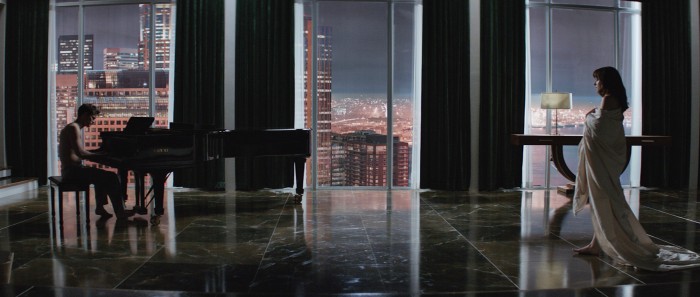A (Partial) Defense Of 'Fifty Shades Of Grey'
Let's get this out of the way: Fifty Shades of Grey* has some massively problematic aspects. Its pathologization of dominant sexual behavior is deeply hypocritical, considering that the movie delights in that exact same behavior. And it's especially distasteful to portray Christian Grey's taste for BDSM sex as unhealthy while glossing over his borderline abusive behavior outside of the bedroom, like his habit of showing up at Anastasia's house uninvited or selling off her possessions without asking.
But to consequently dismiss Fifty Shades of Grey as "bad for women" (or men for that matter) does it and its fans a disservice. For all Fifty Shades of Grey gets wrong about adult relationships and BDSM, it still offers something rare and valuable: a portrait of female sexuality that's entirely by, for, and about women.
(* To clarify, were talking exclusively about Fifty Shades of Grey the movie here. Fifty Shades of Grey the book is a whole different beast, and as I haven't read it I can't discuss it.)
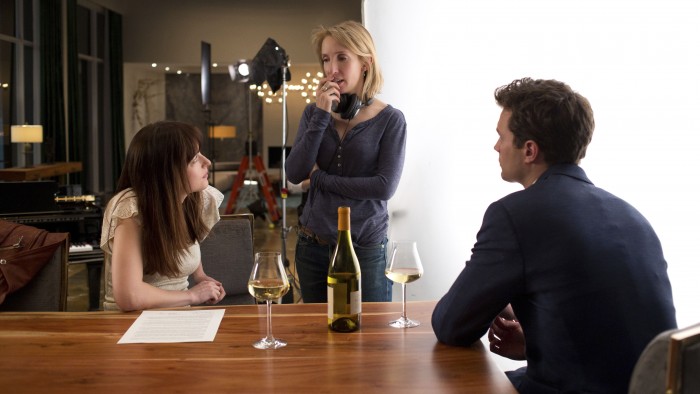 Fifty Shades of Grey is by women.
Fifty Shades of Grey is by women.
Quick, name the last time we got a studio wide release that was directed by a woman, scripted by a woman, and based on a book by a woman. I'm sure it's happened before. But considering that women directed only 7% of the 250 top-grossing movies of 2014, and scripted just 21% of them, I'm going to guess it's exceedingly rare.
And look, I don't want to generalize. I'm not saying any female filmmaker could've directed this film, or that no male filmmaker could have done a better job. But there is something exciting about seeing such a strongly feminine perspective (courtesy of director Sam Taylor-Johnson, screenwriter Kelly Marcel, and author E.L. James) in an industry dominated by male ones. It manifests in some interesting ways, as we'll discuss later.
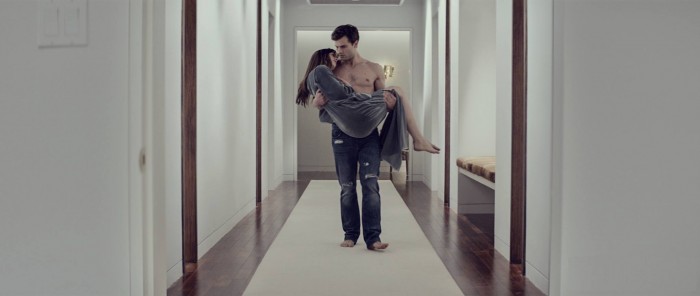 Fifty Shades of Grey is for women.
Fifty Shades of Grey is for women.
Despite copious evidence that male moviegoers are willing to watch a female-led film, and furthermore that a film can still do well at the box office without a large male audience, Hollywood still treats every female-led and/or female-driven success like a jarring anomaly. When a movie does have a female lead, they're buried in snow on the poster, or the "girly" stuff is downplayed in favor of male-friendlier action sequences.
It's refreshing, then, to see a movie that's so unapologetically aimed at women. Men might find Fifty Shades of Grey hot, or they might not. Fifty Shades of Grey doesn't really give a fuck either way. In one telling moment, Ana strips down to reveal leg hair. And pubic hair. It's quite a contrast from the waxed, shaved, buffed, and shined women who feature in most "general" (i.e., male-approved) cinematic fantasies — and something I suspect we might not have seen had Fifty Shades of Grey been shot from a male perspective.
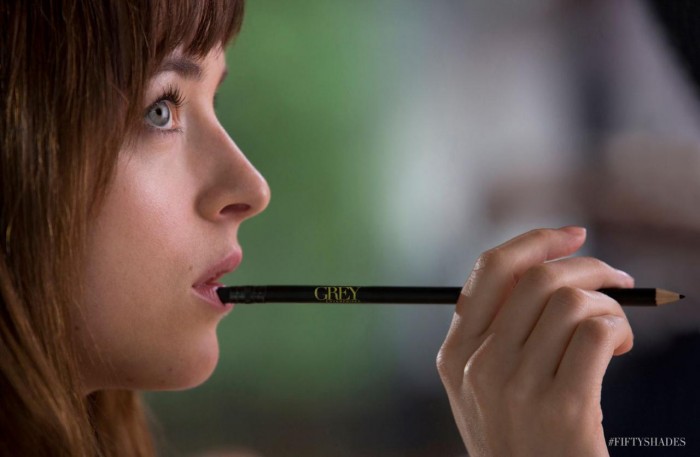 Fifty Shades of Grey is about a woman.Dakota Johnson and Jamie Dornan receive equal billing on the poster, have done similar amounts of press, and gets similar amounts of screentime. But make no mistake: this is Ana's movie. She's the protagonist, the story is told from her point of view, and it's entirely about her journey from a timid virgin to a confident sexual being.
Fifty Shades of Grey is about a woman.Dakota Johnson and Jamie Dornan receive equal billing on the poster, have done similar amounts of press, and gets similar amounts of screentime. But make no mistake: this is Ana's movie. She's the protagonist, the story is told from her point of view, and it's entirely about her journey from a timid virgin to a confident sexual being.
Christian's arc is only relevant to the narrative insofar as it relates to Ana. We get to know him when Ana does, and see him the way Ana does. We care about his character arc because Ana does, not because he himself is of much interest. (To be fair, the last part might be Dornan's fault for being a dull version of Christian.) The only major deviation from Ana's perspective is a late scene in which Christian monologues while Ana is asleep, and even then we're only given the information so we can better understand what's going on with the troubled man that Ana loves so much.
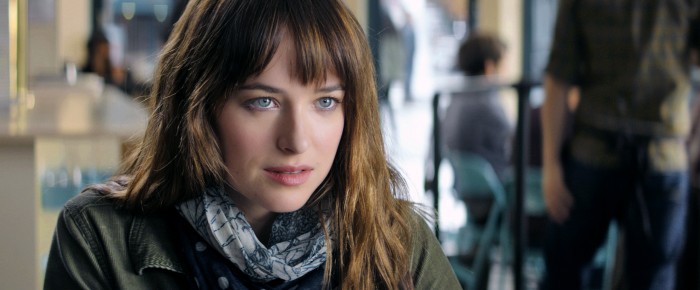 Fifty Shades of Grey's heroine has sexual agency.
Fifty Shades of Grey's heroine has sexual agency.
When we first meet Ana, she's exactly what the shrinking violet you'd expect — shy, naive, and so naturally submissive she doesn't even protest when her roommate steals her sandwich right out of her hands. As it turns out, however, one of the joys of Fifty Shades of Grey is watching her blossom into a confident sexual being.
While Christian is the one who initially pursues Ana, she takes an increasingly proactive role in their relationship. She asks questions, does research, and sets limits. Indeed, the single sexiest scene in the whole film is the one in which Ana calls a business meeting to negotiate her agreement with Christian. Ana isn't being subjugated by Christian; she's making an active decision to let him dominate her on her terms. That distinction makes all the difference.
All the while, Ana continues to push for the romantic relationship she really wants, instead of settling for the purely sexual one Christian prefers. True, a self-admitted commitmentphobe probably isn't the best guy to try and wrest a commitment from — but give the girl credit for knowing what she wants, and going after it.
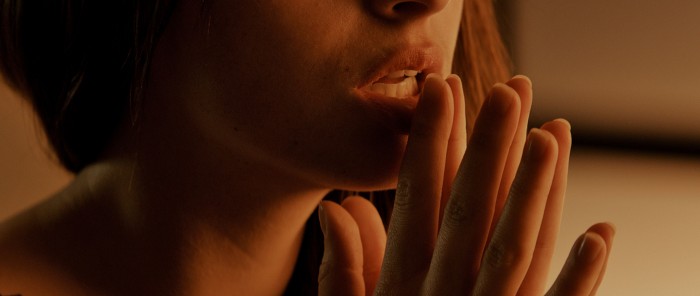 Fifty Shades of Grey focuses on female pleasure.
Fifty Shades of Grey focuses on female pleasure.
Though the whips and chains are Christian's idea, the pleasure is all Ana's. Johnson is plenty naked in this movie — more so, and more often, than her co-star is — but not so we can ogle her beautiful body. It's in service of watching her, and by extension the female audience, receive pleasure.
Not for nothing, the only instance of oral sex in this movie is performed by Christian on Ana. If you don't think that's noteworthy, remember it was just a few years ago that Blue Valentine got slammed with an NC-17 for daring to show Ryan Gosling pretend to go down on Michelle Williams. Meanwhile, Christian claims to enjoy his trysts with Ana, but the movie is not terribly concerned with making sure he gets his rocks off. I'm not sure we even see his O-face in the film, whereas we get many loving shots of Ana shuddering with delight.
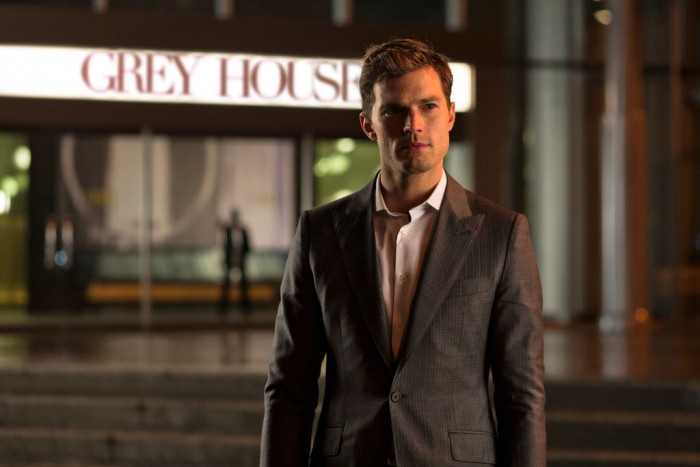 Fifty Shades of Grey is a specifically female fantasy.
Fifty Shades of Grey is a specifically female fantasy.
We see sexual and romantic fantasies play out all the time in mainstream films, but like everything else about mainstream films they tend to be crafted by men and catered toward an assumed male audience. Fifty Shades of Grey offers a peek at a specifically female fantasy, and again, doesn't bother trying to cater to the men in the audience.
That's not to say all women want what Ana does. However, the film does tap into some common themes of female fantasies, from the coercive element of Christian and Ana's dom-sub relationship to Mr. Grey's Mr. Darcy-esque appeal. (For a much more detailed analysis of Fifty Shades of Grey's relationship to female experience and fantasy, check out this excellent essay on EW.)
In fact, Fifty Shades of Grey's version of the female gaze isn't even a gender-flipped version of the male gaze, but its own thing entirely. Dornan isn't objectified to nearly the degree that female stars are in many male-oriented movies. Instead, as discussed above, the camera zeroes in on Ana and the pleasure she's feeling.
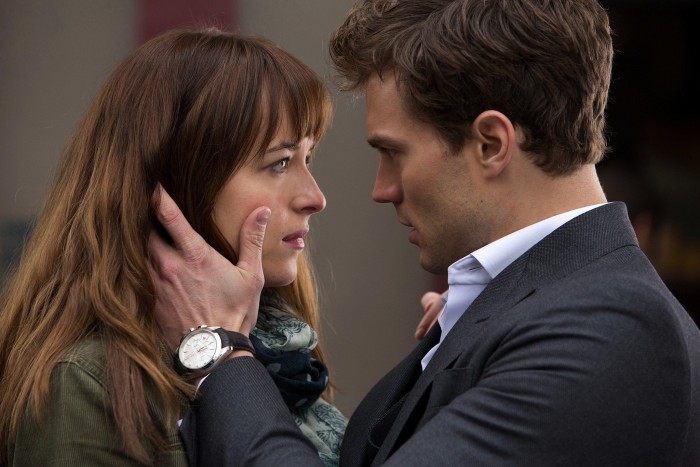 Fifty Shades of Grey is just one movie of many.
Fifty Shades of Grey is just one movie of many.
As I mentioned at the top of this piece, Fifty Shades of Grey is not without some serious issues. And it's absolutely worth pointing those out. People should know that this isn't a healthy BDSM relationship, that Christian's behavior is manipulative at best and downright abusive at worst, that the "sexy" dialogue is an affront to the English language. (I can only imagine Jamie Dornan's resigned sigh when he got to the "I'm fifty shades of fucked up!" line in the script.)
At the same time, one of the reasons Fifty Shades of Grey is getting so much flack is because it bears the burden of representation. We're hyper-aware of the way it treats BDSM or female fantasy because it's so unusual to see those topics treated at all. When a bad comic book movie comes out, you can rest assured another one will be along in a few weeks. It'll be much longer than that before we get another wide release about kinky female sexuality.
On top of that, when those subjects do come up, they tend to be treated as silly and/or strange. So it's easy to fall back into old habits by mocking and vilifying Fifty Shades of Grey out of hand, and to tell women they're better off without this trash. It takes more effort to engage with it honestly and consider what women are actually getting out of it.
Meanwhile, as we're arguing over Fifty Shades of Grey, where's the outrage when yet another male-oriented movie glorifies violence as a macho behavior? Christian's obsession with violent sex is a product of this culture too, after all. Or other films that treat female characters as trophies, accessories, and hurdles? Or suggests that it's sweet, rather than creepy, to direct grand romantic gestures at a reluctant woman?
In sum, critique Fifty Shades of Grey all you want. Lord knows the film has earned a lot of the vitriol it's inspired. But don't rush to make it an all-or-nothing proposition. Consider, for a moment, that the women who've fallen for this story aren't simply idiots who don't know any better. Consider that it's giving audiences something they rarely get. Consider that, like its title, Fifty Shades of Grey may fall somewhere between black and white.
